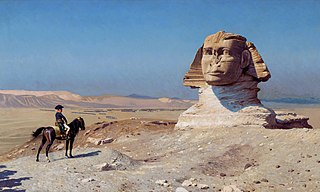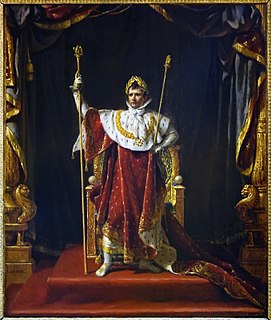 W
WThe Battle of Waterloo is an oil on canvas by William Sadler II made in June 1815.
 W
WThe Black Brunswicker (1860) is a painting by John Everett Millais. It was inspired in part by the exploits of the Black Brunswickers, a German volunteer corps of the Napoleonic Wars, during the Waterloo campaign and in part by the contrasts of black broadcloth and pearl-white satin in a moment of tender conflict.
 W
WBonaparte at the Pont d’Arcole is a 1796 painting by Antoine-Jean Gros, showing an episode during the Battle of Arcole in November 1796, with General Napoleon Bonaparte leading his troops to storm the bridge.
 W
WBonaparte Before the Sphinx is an 1886 painting by the French artist Jean-Léon Gérôme. It is also known as Oedipus (Œdipe). It depicts Napoleon Bonaparte during his Egyptian campaign, positioned on horseback in front of the Great Sphinx of Giza, with his army in the background.
 W
WBonaparte Crossing the Alps is an 1848–1850 oil-on-canvas portrait of Napoleon Bonaparte, by French artist Paul Delaroche. The painting depicts Bonaparte leading his army through the Alps on a mule, a journey Napoleon and his army of soldiers made in the spring of 1800, in an attempt to surprise the Austrian army in Italy. The two main versions of this painting that exist are in the Louvre in Lens and the Walker Art Gallery in Liverpool, England. Queen Victoria also obtained a reduced version of it.
 W
WBonaparte Visits the Plague Stricken in Jaffa is an 1804 painting commissioned by Napoleon Bonaparte by Antoine-Jean Gros to portray an event during the Egyptian Campaign. The scene shows Napoleon during a striking scene which is supposed to have occurred in Jaffa on 11 March 1799, depicting then General Bonaparte making a visit to his sick soldiers at the Armenian Saint Nicholas Monastery. The commission was an attempt to embroider Bonaparte's mythology and quell reports that Napoleon had ordered fifty plague victims in Jaffa be given fatal doses of opium during his retreat from his Syrian expedition.
 W
WBonaparte, First Consul is an 1804 portrait of Napoleon Bonaparte as First Consul by Jean-Auguste-Dominique Ingres. The painting is now in the collection of the Curtius Museum in Liège. Posing the hand inside the waistcoat was often used in portraits of rulers to indicate calm and stable leadership.
 W
WThe Coronation of Napoleon is a painting completed in 1807 by Jacques-Louis David, the official painter of Napoleon, depicting the coronation of Napoleon I at Notre-Dame de Paris. The painting has imposing dimensions, as it is almost 10 metres (33 ft) wide by a little over 6 metres (20 ft) tall and was completed in the medium of oil painting. The work is on display at the Louvre Museum in Paris.
 W
WThe Distribution of the Eagle Standards is an 1810 oil painting by Jacques-Louis David depicting a military ceremony in 1804 that was arranged by Napoleon after his assumption of power as Emperor of the French. In the ceremony, Napoleon sought to revive the military ethos of the Roman Empire.
 W
WThe Emperor Napoleon in His Study at the Tuileries is an 1812 painting by Jacques-Louis David. It shows French Emperor Napoleon I in uniform in his study at the Tuileries Palace. Despite the detail, it is unlikely that Napoleon posed for the portrait.
 W
WNapoleon at Austerlitz is a painting on a theatre drop curtain at the Brown Grand Theatre in Concordia, Kansas. It is a reproduction of a Horace Vernet painting and actually depicts the Battle of Wagram.
 W
WNapoleon Crossing the Alps is any of five versions of an oil on canvas equestrian portrait of Napoleon Bonaparte painted by the French artist Jacques-Louis David between 1801 and 1805. Initially commissioned by the King of Spain, the composition shows a strongly idealized view of the real crossing that Napoleon and his army made across the Alps through the Great St. Bernard Pass in May 1800.
 W
WNapoleon I as Emperor, also known as Napoleon I in his Coronation Robes is an oil on canvas painting by the French artist François Gérard, produced in 1805 under the First French Empire and currently exposed at the Château de Versailles. Gerard initially produced the painting as an official portrait of Napoleon I for his throne room at the Tuileries Palace. It was later moved to the Palace of Versailles. It spent time in the Louvre Museum, at the Élysée Palace from 1849 to 1851 under the presidency of Louis-Napoléon Bonaparte, then at the Château de Saint-Cloud, and returned to Versailles in 1894.
 W
WNapoleon I on his Imperial Throne is an 1806 portrait of Napoleon I of France in his coronation costume, painted by the French painter Jean-Auguste-Dominique Ingres.
 W
WNapoleon in Imperial Costume was an 1805 portrait of Napoleon I in his coronation robes. Originally intended for the Tribuna in Genoa, Napoleon was unhappy with it and it was left incomplete. It is known via a small oil sketch now in the Palais des beaux-arts de Lille.
 W
WNapoleon in the Wilderness is a 1941 surrealist painting by Max Ernst in the collection of the Museum of Modern Art in New York City.
 W
WNapoléon on the Battlefield of Eylau is an oil painting of 1808 by French Romantic painter Antoine-Jean Gros. Completed during the winter of 1807–1808, the work became an icon of the emerging style of French Romanticism. It depicts a moment from the aftermath of the bloody Battle of Eylau in which Napoléon Bonaparte surveys the battlefield where his Grande Armée secured a costly victory against the Russians. Although Napoleon on the Battlefield of Eylau retains elements of history painting, it is by far Gros's most realistic work depicting Napoleon and breaks from the subtlety of Neoclassicism. The painting is housed at the Louvre in Paris.
 W
WWar. The Exile and the Rock Limpet is an oil painting of 1842 by the English Romantic painter J. M. W. Turner (1775–1851). Intended to be a companion piece to Turner's Peace – Burial at Sea, War is a painting that depicts a moment from Napoleon Bonaparte's exile at Saint Helena. In December 1815, the former Emperor was taken by the British government to the Longwood House, despite its state of disrepair, to live in captivity; during his final years of isolation, Napoleon had fallen into despair. Turner's decision to pair the painting with Peace was heavily criticized when it was first exhibited but it is also seen as predecessor to his more famous piece Rain, Steam and Speed – The Great Western Railway (1844).